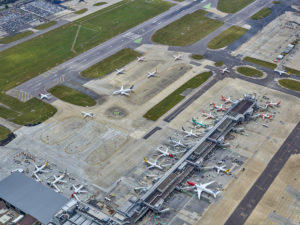Gatwick Airport is urging residents, businesses and other stakeholders to have their say on proposals to develop in a sustainable way in the future.
As one of the South East’s most high profile and important anchor businesses, the UK’s second-busiest international airport has 24,000 direct employees, as well as 13,000 indirect employees, from across the region.
 As part of the airport planning process – and reflecting industry best practice – Gatwick creates and regularly publishes a ‘master plan’ to show how the airport intends to develop and grow in the longer term.
As part of the airport planning process – and reflecting industry best practice – Gatwick creates and regularly publishes a ‘master plan’ to show how the airport intends to develop and grow in the longer term.
Gatwick’s 2018 draft master plan sets out proposals for the airport’s ongoing development and sustainable growth. It explains how the airport can meet the increasing demand for air travel and provide Britain with enhanced global connectivity.
The master plan also demonstrates how it can create new opportunities for the region and continue to bolster the local economy for future generations, while doing everything possible to develop and grow in a sustainable way – striking the right balance between economic growth and environmental impact.
This draft proposal is also a direct response to the Government’s recent call for UK airports to look at ‘making best use of their existing runways’ and we explore how Gatwick could grow across three scenarios:
- MAIN RUNWAY: USING NEW TECHNOLOGIES TO INCREASE CAPACITY
In the near term, the airport has explored how deploying new technology could increase the capacity of the main runway, offering incremental growth through more efficient operations. - STANDBY RUNWAY: BRING EXISTING STANDBY RUNWAY INTO USE
Under its current planning agreement, Gatwick’s existing standby runway is only used when the main runway is closed for maintenance or emergencies. However, the 40-year planning agreement will come to an end in 2019. The draft master plan sets out for the first time how we could potentially bring our existing standby runway into routine use for departing flights, alongside the main runway, by the mid-2020s. This innovative development, which would meet all international safety requirements, would be delivered without increasing the airport’s noise footprint and provide greater operational resilience. - ADDITIONAL RUNWAY: SAFEGUARDING FOR THE FUTURE
While we are not actively pursuing the option of a building a brand new runway to the south of the airport – as we did through the Airports Commission process – we believe it is in the national interest to continue to safeguard this land for the future as part of our master plan.
Comments are being invited on the proposal until 5pm on 10 January 2019.
To see the the full draft master plan visit this link. A full length video also explains the proposals in further detail.
